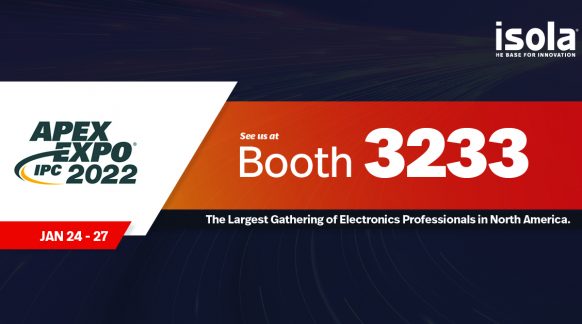How Do Material Qualities Differ for HSD Versus mmWave Circuits?
Growing use of millimeter-wave (mmWave) frequencies for applications such as automotive radars, Fifth Generation (5G) wireless networks, and satellite communications (satcom) mandates careful selection of printed-circuit-board (PCB) materials specially formulated to transmit signals at frequencies to 70 GHz and higher. At the same time, digital signals are moving at higher rates, often within the same electronic systems as RF/microwave and mmWave signals. Are high-speed-digital (HSD) signals and high-frequency analog signals different enough to require their own PCB materials and, if so, what should the material requirements be for each type of circuit? This blog will explore the differences in high-frequency analog and HSD transmission and circuit material characteristics best suited for each type, along with some examples of laminates and prepregs from Isola Group that cost-effectively satisfy the signal transmission requirements with the combination of excellent performance, straightforward processing, and can be combined as space and cost-saving hybrid assemblies.
Why use different laminates and prepregs for HSD and RF/microwave/mmWave designs? The signal waveforms are quite different. Analog signals are continuous, maintaining an amplitude value over time. Digital signals on the other hand have long been considered as “on” and “off” in nature. They are bits or zeroes, rising quickly from no amplitude value to a discrete amplitude value and then falling back to zero, appearing much like a pulsed waveform. The signal values must be at least close to be detected as bits, whereas the amplitude of analog signals, often with some form of modulation to carry information, must be precise with as little loss as possible.
Because of the importance of preserving signal strength in analog signals, especially at higher frequencies where signal power is less available, it might seem a simple matter to select a PCB material with the lowest loss or dissipation factor (Df) at mmWave frequencies. Then, why not use the same material for HSD signals? Such low-loss circuit material can significantly raise the costs of HSD circuits, especially with longer transmission lines, and the HSD circuitry will occupy PCB real estate that might have been used by analog mmWave signals. A more practical approach to achieve cost-effective mixed-signal circuits is via a hybrid combination of different circuit materials, with each material selected according to the requirements of the different signal types.
Which circuit material properties should be considered for each type of signal, given that analog signals are increasingly needed for mmWave applications and HSD signals at Gb/s speeds? Low loss (low Df) is certainly crucial for mmWave PCBs. Another important mmWave PCB material parameter is consistent permittivity or dielectric constant (Dk) across operating temperature and frequency. With such small wavelengths, analog mmWave signals can bend or reflect with physical changes in a transmission line, such as a right-angle bend, or with variations in characteristic impedance (usually 50 Ω). Impedance changes with Dk, so any PCB material candidate for mmWave frequencies should have little or no variation in Dk with temperature and frequency. Unwanted signal reflections can result in electromagnetic interference (EMI) and disruptions in the way an analog circuit performs or even in bit errors in a nearby HSD circuit.
For HSD applications, consistency in Dk with temperature and frequency is important, although not as critical as for mmWave designs. HSD signals are more tolerant of impedance variations than mmWave signals, although the tolerance diminishes with increasing bit rate. Still, PCB materials for HSD circuits should support transmission lines and interconnections with minimal impedance variations to enable the efficient transfer of the numerous signal components that form HSD signals, including fundamental tones and higher-order harmonics, such as a second-harmonic frequency of 20 GHz for an HSD rate of 10 Gb/s.
Transmission lines with little or no variations from the characteristic impedance maintain high signal integrity (SI) in HSD circuits; fabrication of such lines requires PCB materials with consistent Dk characteristics. At the same time, low Df is not as critical for HSD designs as for mmWave circuits and a cost-effective material with consistent Dk and higher Df can be used for an HSD PCB versus a mmWave circuit at the same frequency.
Real-World Examples
How do real-world examples of PCB materials developed for mmWave versus HSD circuits compare? Astra® MT77 is a low-loss laminate and prepreg from Isola-Group with characteristics that enable the fabrication of mmWave circuits to frequencies at 100 GHz and higher. In comparison, Tachyon® 100G, also from Isola, is a low-loss laminate and prepreg for HSD signals to 100 Gb/s and beyond. The materials are similar in many ways except for key traits in favor of mmWave signals and HSD signals, respectively.
Astra® MT77 features the low loss desirable for mmWave signals, with a Df of typically 0.0017 at 10 GHz. It has Dk that is consistent with frequency, 3.0 in the z-axis (thickness) at both 2 and 10 GHz, and with temperature from -40 to +140°C. Tachyon® 100G laminates and prepregs don’t quite match the frequency-consistent Dk characteristics of Astra® MT77, with Dk that decreases slightly with frequency, from 3.04 at 2 GHz to 3.02 at 10 GHz, both in the z-axis or thickness, and stable with temperatures from -55 to +125°C. They also have higher loss, with Df of typically 0.0021 at 10 GHz, than Astra® MT77 but still well suited for HSD circuits. The two materials are well matched in thermal characteristics, such as their coefficients of thermal expansion (CTE) in the z and x/y axes and thermal conductivity, to facilitate their teaming in mixed-signal hybrid circuits where the materials are matched to the types of (mmWave or HSD) signals and then joined in a compact multilayer assembly with minimal variations in performance across temperature and frequency. Both materials are also FR-4 process compatible to encourage combining them with low-cost FR-4 substrates has part of hybrid circuit assemblies.
Circuit designers concerned about combining mmWave and HSD signals within a compact circuit assembly that can be manufactured by halogen-free processing may want to explore the different TerraGreen® laminates and prepreg materials from Isola, including TerraGreen® (HSD) with characteristics well suited for HSD signals and TerraGreen® (RF/MW) with the low loss needed for RF/microwave and mmWave analog signals. Both materials maintain Dk that is constant with temperatures from -55 to +125°C and consistent with frequency, at 3.44 in the z-axis at 2, 5, and 10 GHz for TerraGreen® (HSD) and 3.45 in the z-axis at 2, 5, and 10 GHz for TerraGreen® (RF/MW). TerraGreen® (RF/MW) has high power-handling capability, with thermal conductivity of 0.63 W/m-K compared to lower values around 0.32 W/m-K for typical FR-4 materials. Otherwise, they are well matched for hybrid mmWave/HSD assemblies in terms of mechanical changes with temperature, both exhibiting a three-axis CTE of 2.9% across the full operating temperature range.
Whether for HSD or mmWave designs, longer line lengths mean higher losses no matter which circuit material is the starting point, so transmission lines should be kept as short as possible. However, with a hybrid approach, a lower-loss material can be used for the mmWave portions with a more cost-effective but still suitable material composition for HSD circuitry.
Since loss is so critical at mmWave frequencies, the next blog in this series will investigate material requirements to produce truly low-loss circuits and why skimping on these materials can sometimes be costly in the long run.

by Jim Francey, RF Business Development Director Europe, Isola Group
01 June 2022


